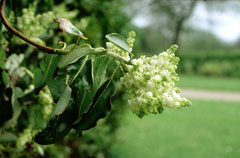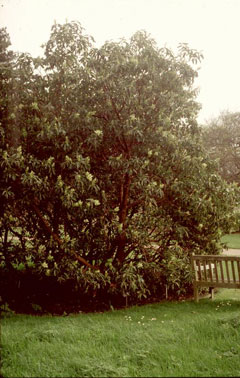 |
|
(c) 2010 Ken Fern & Plants For A Future |
 |
| (c) 2010 Ken Fern & Plants For A Future |
Translate this page:
Summary
Pacific madrone is the largest North American Arbutus, a striking evergreen tree reaching up to 30 meters tall. It is widespread in the Pacific states from California north into Oregon, Washington, and British Columbia. Its smooth, peeling red bark and glossy oval leaves make it one of the most distinctive trees of the coastal forests. Bloom Color: White.
Main Bloom Time: Early spring, Late spring, Mid spring. Form: Oval, Upright or erect.
Physical Characteristics

 Arbutus menziesii is an evergreen Tree growing to 15 m (49ft) by 15 m (49ft) at a medium rate.
Arbutus menziesii is an evergreen Tree growing to 15 m (49ft) by 15 m (49ft) at a medium rate.
See above for USDA hardiness. It is hardy to UK zone 7. It is in leaf all year, in flower from April to May, and the seeds ripen in October. The species is hermaphrodite (has both male and female organs) and is pollinated by Bees. The plant is self-fertile.
Suitable for: light (sandy) and medium (loamy) soils and prefers well-drained soil. Suitable pH: mildly acid soils and can grow in very acid soils.
It can grow in semi-shade (light woodland) or no shade. It prefers dry or moist soil.
UK Hardiness Map
US Hardiness Map
Synonyms
A. procera.
Plant Habitats
Woodland Garden Secondary; Sunny Edge; Dappled Shade;
Edible Uses
Edible Parts: Fruit
Edible Uses:
Like its relatives, the red bumpy berries are edible when ripe, though large quantities may cause nausea. They are sweet but somewhat bland, soft-seeded, and easy to process into flour, cider, wine, or preserves. Pacific madrone fruits were widely used by Native American groups in its range, often eaten fresh, dried, or brewed into beverages [2-3]. Edibility rating: 3/5 – Palatable fruits, significant ethnobotanical history, but modest flavor [2-3]. Fruit - raw or cooked[2, 92, 105, 161, 183]. A bland taste[229]. Very sour according to another report[226]. After boiling the fruit can be dried for later use[183]. The fruit is about 15mm in diameter[200].
References More on Edible Uses
Medicinal Uses
Plants For A Future can not take any responsibility for any adverse effects from the use of plants. Always seek advice from a professional before using a plant medicinally.
Astringent Miscellany Stomachic Vulnerary
The leaves are stomachic and vulnerary[168, 257]. They can be used in the treatment of stomach ache and cramps, colds etc[257]. The leaves can be applied as a poultice to burns[257]. The bitter principles in the bark and leaves can be used as an astringent[229]. An infusion of the bark has been used in the treatment of diabetes and externally to treat sores, cuts and wounds[257]. It has also been used as a gargle for sore throats[257].
References More on Medicinal Uses
The Bookshop: Edible Plant Books
Our Latest books on Perennial Plants For Food Forests and Permaculture Gardens in paperback or digital formats.

Edible Tropical Plants
Food Forest Plants for Hotter Conditions: 250+ Plants For Tropical Food Forests & Permaculture Gardens.
More

Edible Temperate Plants
Plants for Your Food Forest: 500 Plants for Temperate Food Forests & Permaculture Gardens.
More

More Books
PFAF have eight books available in paperback and digital formats. Browse the shop for more information.
Shop Now
Other Uses
Charcoal Dye Miscellany Tannin Wood
Fruits were traditionally dried or fermented into cider. The tree provides habitat and food for birds and mammals, while its hard wood was used for fuel and small wooden items. Pacific madrone is also planted ornamentally for its dramatic bark and evergreen character. The inner bark was sometimes used by native North American Indians to make dresses[257]. The leaves can be used to test the temperature of pitch that is being used to waterproof canoes. When the leaves turn black the pitch is ready to use[257]. A brown dye is obtained from the bark[57, 106], it does not need a mordant[168]. Use in spring or summer[168]. The bark is a rich source of tannin[46, 61, 82, 226], it is used medicinally[168]. The tannin is also used as a preservative on wood, ropes etc[257]. Wood - very hard, brittle, durable in water, close grained, heavy, strong. The wood does not split when it dries and so has been used for carving[257]. It is also sometimes used for making furniture, it also produces a fine grade of charcoal[46, 61, 82, 99, 229].
Special Uses
Scented Plants
References More on Other Uses
Cultivation details
Landscape Uses:Specimen. Requires a lime-free nutrient-rich well-drained moisture-retentive soil in sun or semi-shade and shelter from cold drying winds, especially when young[200]. Succeeds in a limy soil according to another report[182]. Hardy to about -10°c[200], trees succeed outdoors at Kew but shoots of young plants are apt to be cut back in winter[11]. They grow very well in S.W. England[11]. An ideal plant for the small garden or as a lawn specimen, it has a neat, compact, upright growth habit, retaining its lower leafy branches close to the ground and casting little shade[245]. The flowers have a honey-like fragrance which will pervade the whole garden on calm days[245]. Trees are slow-growing in the wild, living up to 225 years[229], though they are fairly fast growing in cultivation when young[11]. They dislike being transplanted and should be placed in their final positions as soon as possible[11, 134, 166]. Give them some protection in their first winter outdoors. This species is notably resistant to honey fungus[200]. Special Features:North American native, Fragrant flowers, Attractive flowers or blooms.
References Carbon Farming Information and Carbon Sequestration Information
Temperature Converter
Type a value in the Celsius field to convert the value to Fahrenheit:
Fahrenheit:
The PFAF Bookshop
Plants For A Future have a number of books available in paperback and digital form. Book titles include Edible Plants, Edible Perennials, Edible Trees,Edible Shrubs, Woodland Gardening, and Temperate Food Forest Plants. Our new book is Food Forest Plants For Hotter Conditions (Tropical and Sub-Tropical).
Shop Now
Plant Propagation
Seed - best surface sown in a cold frame as soon as it is ripe. Stored seed should be soaked for 5 - 6 days in warm water and then surface sown in a shady position in a greenhouse[78]. Do not allow the compost to become dry. 6 weeks cold stratification helps[134]. The seed usually germinates well in 2 - 3 months at 20°c[134]. Seedlings are prone to damp off[184], they are best transplanted to individual pots as soon as they are large enough to handle and should be kept well ventilated. Grow them on in a greenhouse for their first winter and then plant out in late spring after the last expected frosts[K]. Basal cuttings in late winter[200]. Cuttings of mature wood of the current season's growth, November/December in a frame. Poor percentage[78]. Layering of young wood - can take 2 years[1, 200].
Other Names
If available other names are mentioned here
Pacific Madrone (Arbutus menziesii Pursh)
Native Range
NORTHERN AMERICA: Canada (British Columbia (southwest)), United States (Oregon (west), Washington (west), California)
Weed Potential
Right plant wrong place. We are currently updating this section.
Please note that a plant may be invasive in one area but may not in your area so it's worth checking.
None. It is a slow-establishing native with limited spread.
Conservation Status
IUCN Red List of Threatened Plants Status :

Growth: S = slow M = medium F = fast. Soil: L = light (sandy) M = medium H = heavy (clay). pH: A = acid N = neutral B = basic (alkaline). Shade: F = full shade S = semi-shade N = no shade. Moisture: D = dry M = Moist We = wet Wa = water.
Now available:
Food Forest Plants for Mediterranean Conditions
350+ Perennial Plants For Mediterranean and Drier Food Forests and Permaculture Gardens.
[Paperback and eBook]
This is the third in Plants For A Future's series of plant guides for food forests tailored to
specific climate zones. Following volumes on temperate and tropical ecosystems, this book focuses
on species suited to Mediterranean conditions—regions with hot, dry summers and cool, wet winters,
often facing the added challenge of climate change.
Read More
Expert comment
Author
Pursh.
Botanical References
1160200
Links / References
For a list of references used on this page please go here
Readers comment
© 2010, Plants For A Future. Plants For A Future is a charitable company limited by guarantee, registered in England and Wales. Charity No. 1057719, Company No. 3204567.